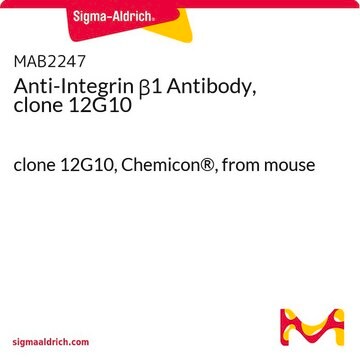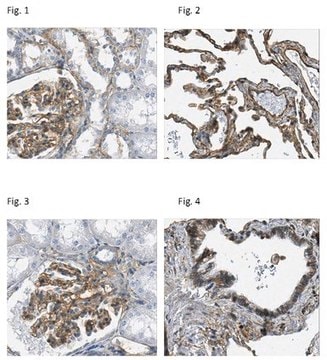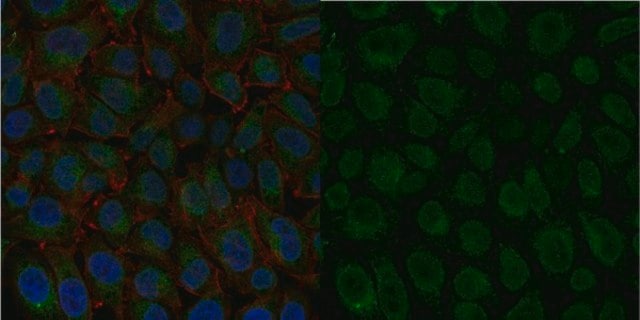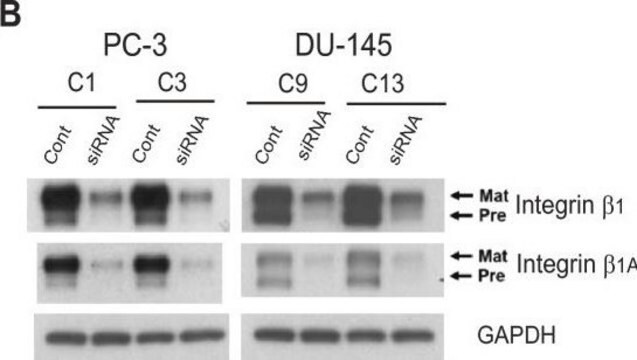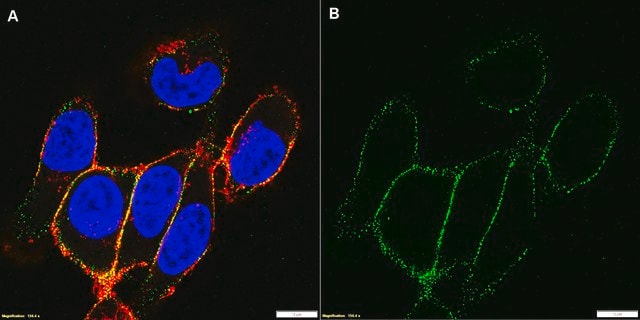MAB1997
Anti-Integrin β1 Antibody, clone MB1.2
clone MB1.2, Chemicon®, from rat
Synonym(s):
CD29 antigen, Fibronectin receptor subunit beta, Integrin VLA-4 subunit beta, fibronectin receptor beta subunit, integrin VLA-4 beta subunit, integrin beta 1, integrin beta 1 (fibronectin receptor, beta polypeptide, antigen CD29 includes MDF2, MSK12)
About This Item
Recommended Products
biological source
rat
Quality Level
antibody form
purified immunoglobulin
antibody product type
primary antibodies
clone
MB1.2, monoclonal
species reactivity
mouse, human
species reactivity (predicted by homology)
rat
packaging
antibody small pack of 25 μg
manufacturer/tradename
Chemicon®
technique(s)
flow cytometry: suitable
immunohistochemistry: suitable
immunoprecipitation (IP): suitable
western blot: suitable
isotype
IgG2κ
NCBI accession no.
UniProt accession no.
shipped in
ambient
storage temp.
2-8°C
target post-translational modification
unmodified
Gene Information
human ... ITGB1(3688)
General description
Specificity
Immunogen
Application
A previous lot of this anitbody was used to immunoprecipitate VLA (β1) integrins from lysate of 106 cell equivalent: 2 μg.
Flow cytometry:
A 10 μg/mL concentration of a previous lot was used in FC.
Immunohistochemistry in frozen tissue sections:
20 μg/mL from a previous lot was used. As a result of the wide tissue distribution of VLA (β1), binding of MAB1997 to diverse cell types is commonly observed.
Does not block VLA integrin mediated cell adhesion to matrix proteins. Activation of VLA (β1) integrin signaling properties by MAB1997 has not been characterized.
Western blot:
10 µg/mL. Effective for samples that have been SDS-denatured and heated. Not effective for reduced samples.
Optimal working dilutions must be determined by end user.
Quality
Western Blot Analysis:
1:1000 dilution of this lot detected integrin β1 on 10 μg of C2C12 lysate.
Target description
Linkage
Physical form
Analysis Note
Human OVCAR5 cell line whole cell lysate
C2C12 lysate.
Other Notes
Legal Information
Not finding the right product?
Try our Product Selector Tool.
recommended
Storage Class Code
12 - Non Combustible Liquids
WGK
WGK 2
Flash Point(F)
Not applicable
Flash Point(C)
Not applicable
Certificates of Analysis (COA)
Search for Certificates of Analysis (COA) by entering the products Lot/Batch Number. Lot and Batch Numbers can be found on a product’s label following the words ‘Lot’ or ‘Batch’.
Already Own This Product?
Find documentation for the products that you have recently purchased in the Document Library.
Our team of scientists has experience in all areas of research including Life Science, Material Science, Chemical Synthesis, Chromatography, Analytical and many others.
Contact Technical Service

